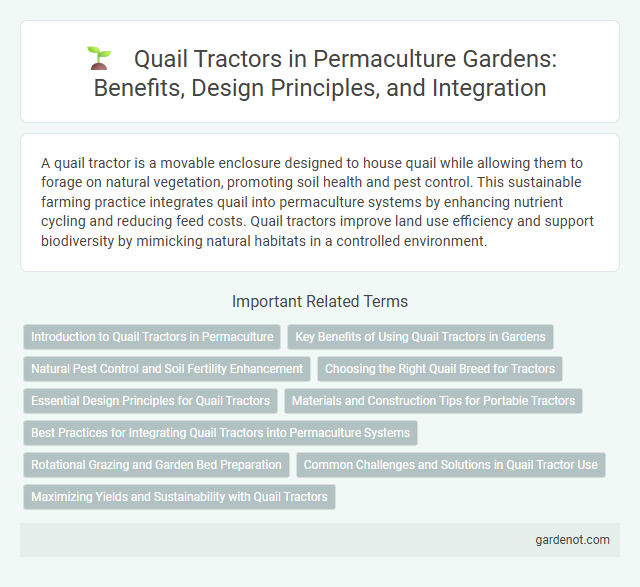A quail tractor is a movable enclosure designed to house quail while allowing them to forage on natural vegetation, promoting soil health and pest control. This sustainable farming practice integrates quail into permaculture systems by enhancing nutrient cycling and reducing feed costs. Quail tractors improve land use efficiency and support biodiversity by mimicking natural habitats in a controlled environment.
Introduction to Quail Tractors in Permaculture
Quail tractors in permaculture are mobile, portable enclosures that allow quails to forage naturally while providing soil health benefits through their droppings and scratching behavior. These compact coops support sustainable food production by integrating pest control, fertilization, and weed management into garden ecosystems. Utilizing quail tractors enhances biodiversity and promotes efficient land use in regenerative farming practices.
Key Benefits of Using Quail Tractors in Gardens
Quail tractors enhance garden efficiency by providing natural pest control through quails that consume insects and larvae, reducing the need for chemical pesticides. They improve soil fertility as quail droppings act as nutrient-rich compost, promoting healthy plant growth. The mobile design allows targeted soil aeration and weed control, fostering sustainable garden ecosystems.
Natural Pest Control and Soil Fertility Enhancement
Quail tractors provide an eco-friendly solution for natural pest control by allowing quails to forage freely, consuming insects and larvae that harm crops. Their droppings serve as a rich source of organic fertilizer, enhancing soil fertility and promoting nutrient cycling. Integrating quail tractors into permaculture systems supports sustainable agriculture by reducing chemical inputs and improving soil health.
Choosing the Right Quail Breed for Tractors
Selecting the right quail breed for quail tractors significantly impacts productivity and sustainability in permaculture systems. Japanese quail (Coturnix japonica) are favored for their rapid growth, high egg production, and adaptability to confined environments, making them ideal for tractor setups. Heritage breeds may offer unique traits such as disease resistance but typically require more space and care, necessitating careful matching to tractor design and farm goals.
Essential Design Principles for Quail Tractors
Quail tractors integrate key permaculture design principles such as maximizing space efficiency through rotational grazing to enhance soil fertility and pest control. Incorporating natural shelter and ventilation ensures quail welfare while promoting sustainable ecosystem functions. Durable, lightweight materials facilitate mobility, aligning with the principle of minimizing external inputs and energy use.
Materials and Construction Tips for Portable Tractors
Quail tractors are typically constructed using lightweight materials such as PVC pipes, chicken wire, and untreated wood to ensure portability and durability. For optimal airflow and predator protection, secure the wire mesh tightly and reinforce corners with sturdy wooden frames. Incorporating wheels or handles made from reclaimed materials can enhance mobility, allowing the tractor to be easily moved across garden beds in permaculture systems.
Best Practices for Integrating Quail Tractors into Permaculture Systems
Quail tractors enhance permaculture systems by providing sustainable pest control, natural fertilizer, and the efficient use of space through mobile habitat design. Best practices include rotating the tractors regularly to prevent soil compaction, integrating diverse plant species for varied quail diets, and ensuring adequate shelter and water to maintain quail health and productivity. Strategic placement near compost piles and garden beds maximizes nutrient cycling and supports overall ecosystem balance.
Rotational Grazing and Garden Bed Preparation
Quail tractors facilitate rotational grazing by allowing controlled movement of quails across garden beds, enhancing soil fertility through natural manure distribution. This method promotes pest control and nutrient cycling, which prepares the garden beds for planting without chemical inputs. Implementing quail tractors in permaculture systems optimizes garden bed health and boosts ecosystem resilience.
Common Challenges and Solutions in Quail Tractor Use
Common challenges in quail tractor use include managing waste accumulation, preventing predator access, and ensuring adequate ventilation to maintain bird health. Solutions involve implementing regular cleaning schedules, reinforcing protective barriers with hardware cloth or electric fencing, and designing quail tractors with adjustable vents or screened windows for optimal airflow. Properly balancing these elements enhances quail wellbeing and productivity within rotational grazing systems.
Maximizing Yields and Sustainability with Quail Tractors
Quail tractors enhance permaculture systems by providing mobile, nutrient-rich fertilization directly to the soil while optimizing space for multiple crops. These portable enclosures maximize yields through natural pest control and soil aeration as quails forage and scratch. Integrating quail tractors supports sustainable farming by reducing chemical inputs and promoting regenerative soil health.
Quail tractor Infographic

 gardenot.com
gardenot.com